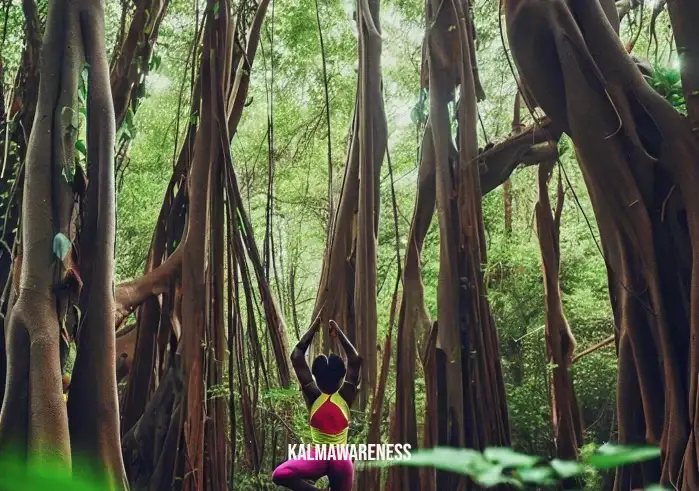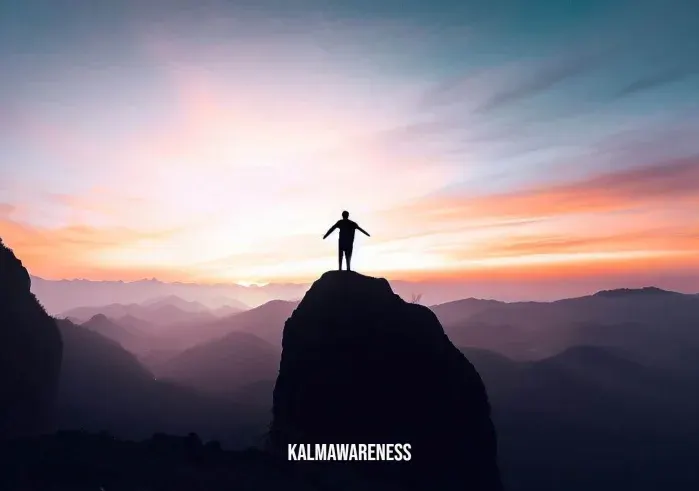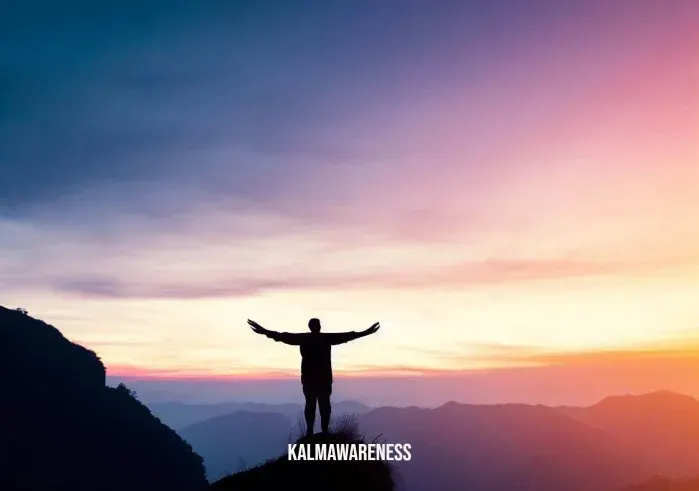Embrace the Power of the Mind in Yoga: An Exploration into Mind Pose Yoga
When we talk about yoga, what often comes to mind are various physical poses and stretches. However, yoga is a holistic practice, which also significantly involves the mind. In this article, we delve into the fascinating realm of Mind Pose Yoga. This form of yoga, intimately related to Asana, Meditation, Breathwork, Mindfulness, and Flexibility, illuminates how we can embrace the mental aspect of yoga to achieve overall wellness.
The Synergy Between Mind and Body
“Yoga is the journey of the self, through the self, to the self.” – The Bhagavad Gita
To truly harness the power of yoga, we must recognize that it’s not merely a collection of physical exercises but a practice that aims to harmonize the body, mind, and spirit. This understanding is central to the relationship between yoga and meditation, where both disciplines encourage us to tune into our inner selves, promoting mindfulness and presence.
Mind Pose Yoga takes this concept further by actively incorporating mental exercises into the yoga practice. It combines the physical elements of yoga, like the twisted root yoga pose, with mindfulness techniques to create a unique practice that nurtures not only the body but also the mind.
Mind Pose Yoga: Unfolding the Practice
The essence of Mind Pose Yoga lies in its emphasis on mental poses or states of mind, rather than just focusing on physical postures. These mental poses could be peace, tranquility, determination, or courage, each resonating deeply with various aspects of our lives.
For example, when practicing affectionate breathing, one can adopt a mental pose of love and compassion, mentally ‘stretching’ and ‘flexing’ their capacity for these emotions. Such mental poses work in harmony with physical ones, creating a practice that engages both mind and body.
But how do you incorporate these mental poses into your practice?
Mental Poses: A New Approach
Incorporating mental poses begins with understanding and acknowledging your emotional landscape. During your yoga session, rather than just moving through the physical poses, take a moment to identify a feeling or emotion that resonates with you. For instance, during a demanding pose like hand yoga poses, one could adopt a mental pose of resilience or strength, amplifying the benefits of the physical practice.
Being aware of your thoughts, and recognizing that they are not facts but merely subjective interpretations, can play a significant role in your mental poses. This awareness, combined with the physical practice of yoga, becomes a powerful tool for enhancing mental well-being and resilience.
In the next part of this article, we’ll delve deeper into how to effectively incorporate Mind Pose Yoga into your regular yoga practice. We’ll also explore the profound benefits it can offer in terms of improved mindfulness, enhanced emotional intelligence, and overall mental well-being. Stay tuned for a more insightful exploration of Mind Pose Yoga!

Expanding the Benefits of Mind Pose Yoga
In the first chapter, we began a journey of understanding the holistic practice of Mind Pose Yoga. Now, as we delve deeper, let’s unfold more layers of this practice and comprehend how it can enhance your yoga sessions while benefiting your mental health and overall well-being.
The Pillars of Mind Pose Yoga
Mind Pose Yoga hinges on two primary pillars: physical poses and mental poses. Each pillar plays an essential role in creating a well-rounded practice. The physical poses in yoga, or asanas, aim to increase flexibility and strengthen the body. These poses can range from simple stretches to more complex postures like the Twisted Tree Yoga Pose.
On the other hand, mental poses target the mind, encouraging practitioners to cultivate certain mindsets or emotions during their practice. These could include compassion, gratitude, resilience, or peace, among others.
Transformative Effects of Mind Pose Yoga
The effects of Mind Pose Yoga can be transformative, enhancing not only your yoga practice but also your overall approach to life. Here are some of the benefits you can experience with regular practice:
- Improved Mind-Body Connection: Through Mind Pose Yoga, you foster a stronger connection between your body and mind. This enhanced connection can help you become more in tune with your body, improving your yoga practice and overall well-being.
- Enhanced Emotional Intelligence: By incorporating mental poses that engage with various emotions, you can expand your emotional intelligence. Understanding and acknowledging emotions like compassion or resilience in your practice can also assist you in handling life’s waves of change more effectively.
- Boosted Mindfulness: Mind Pose Yoga is a potent mindfulness tool, encouraging you to stay present in each moment. By adopting specific mental poses, you can create room for spontaneity, enhancing your ability to live in the now.
- Increased Resilience: The practice of Mind Pose Yoga involves maintaining a specific mental pose, often mirroring the physical pose’s difficulty. This practice can cultivate resilience, aiding you in navigating life’s challenges with greater ease.
The table below illustrates how you can incorporate specific mental poses into your practice alongside the physical ones:
| Physical Pose | Corresponding Mental Pose |
|---|---|
| Mountain Pose (Tadasana) | Steadfastness |
| Warrior Pose (Virabhadrasana) | Courage |
| Child’s Pose (Balasana) | Surrender |
| Corpse Pose (Savasana) | Release |
In the final chapters of this article, we’ll explore some of the core mental poses you can adopt in your Mind Pose Yoga practice and offer practical tips to help you integrate this approach into your daily routine. We’ll dive deeper into the intricacies of emotional intelligence, mindfulness, and resilience, all integral aspects of the transformative journey of Mind Pose Yoga. Stay tuned!

Cultivating Mind Poses: The Secret Sauce of Mind Pose Yoga
The concept of Mind Pose Yoga has sparked an exciting transformation in the way we approach traditional yoga. After exploring the concept and its profound benefits, we now delve into the nuances of developing the mental poses, the distinguishing factor of Mind Pose Yoga.
Incorporating mental poses into your practice takes more than just choosing an emotion and hoping for the best. It involves a deep and sincere effort to invite these feelings and mindsets into your practice, cultivating them through your poses and breathwork.
The Art of Cultivating Mental Poses
“The success of Yoga does not lie in the ability to perform postures but in how it positively changes the way we live our life and our relationships.” – T.K.V. Desikachar
Understanding that our thoughts are not facts is the first step towards cultivating mental poses. We often get caught up in our thoughts, interpreting them as absolute truths. However, by cultivating the mental pose of openness or non-judgment, we can observe our thoughts without getting entangled in them.
“Yoga is not a work-out, it is a work-in. And this is the point of spiritual practice; to make us teachable; to open up our hearts and focus our awareness so that we can know what we already know and be who we already are.” – Rolf Gates
Cultivating mental poses also involves developing a keen awareness of our breath. Our breath is a powerful tool that can help us tap into our emotional states. Techniques such as deep inhale and belly breathing meditation can help create a state of calmness and focus that supports the cultivation of mental poses.
“When you own your breath, nobody can steal your peace.” – Unknown
Another essential part of cultivating mental poses is the practice of non-reactivity. Yoga encourages us to witness our feelings and experiences without reacting to them impulsively. This non-reactive approach can help us foster mental poses such as peace and acceptance, even in challenging postures.
“Yoga is a light, which once lit, will never dim. The better your practice, the brighter the flame.” – B.K.S. Iyengar
Finally, consistent practice is key. Just like the physical postures, mental poses take time to develop. You may not master the art of cultivating mental poses right away, but with continuous practice, you’ll begin to see progress.
Incorporating Mind Poses into Your Practice
Now that you understand the art of cultivating mental poses, you may be wondering how to incorporate them into your practice. Here’s a quick guide to help you get started:
- Set an Intention: Before you begin your practice, choose a mental pose that you wish to cultivate. This could be something you feel lacking or something you wish to deepen in your life.
- Sync with Your Breath: As you move through your physical poses, sync your breath with your movements. Use breathwork techniques to help you focus and invite your chosen mental pose into your practice.
- Stay Present: Remember to keep your focus on the present moment throughout your practice. Even if your mind wanders, gently bring your attention back to your breath and your chosen mental pose.
- End with Gratitude: At the end of your practice, take a moment to express gratitude for the time and energy you dedicated to your Mind Pose Yoga session. This helps to seal your practice and reinforces the positive impacts of your chosen mental pose.
In the next chapter, we’ll dive into some specific mental poses you can incorporate into your practice and provide some more practical tips for mastering Mind Pose Yoga. We’ll also discuss how to navigate any challenges you might face in your journey. See you in the next chapter!

Mind Pose Yoga: Mental Poses to Transform Your Practice
The third chapter of our exploration into Mind Pose Yoga takes us into the heart of this transformative practice – the mental poses. As we have discussed, Mind Pose Yoga integrates the cultivation of specific mental states, or “mental poses,” into traditional yoga practice. This chapter will introduce some common mental poses you can cultivate and provide a table summarizing their associated benefits.
Common Mental Poses in Mind Pose Yoga
“The very heart of yoga practice is ‘abyhasa’ – steady effort in the direction you want to go.” – Sally Kempton
Mind Pose Yoga is not a one-size-fits-all approach; the mental poses you choose to cultivate can vary based on your individual needs and aspirations. Here are some common mental poses that can help enrich your yoga experience:
- Calm: Andres Gonzales, a renowned yoga practitioner, often emphasizes the importance of nurturing a calm mind. Invoking a sense of calm during your practice can help manage stress and reduce anxiety.
- Joy: Cultivating joy as a mental pose can lift your spirits and inspire a more positive outlook. This is particularly beneficial if you’re going through a challenging phase in your life.
- Compassion: Embodying compassion towards yourself and others can promote empathy and understanding. It also encourages a gentler approach to your practice, preventing injury and promoting recovery.
- Non-Judgment: Non-judgment, as explored in our ACT Meditation article, allows us to observe our feelings and experiences without attaching any labels or criticisms to them.
- Openness: Cultivating a sense of openness encourages us to be receptive to new experiences, perspectives, and opportunities. This is especially useful if you find yourself stuck in repetitive patterns or if you’re facing significant changes.
“Change is not something that we should fear. Rather, it is something that we should welcome. For without change, nothing in this world would ever grow or blossom, and no one in this world would ever move forward to become the person they’re meant to be.” – B.K.S Iyengar
Table of Mental Poses and Their Benefits
| Mental Pose | Benefits |
|---|---|
| Calm | Reduces stress and anxiety, Promotes mental clarity |
| Joy | Boosts mood, Fosters positivity |
| Compassion | Promotes empathy, Encourages a gentler approach to practice |
| Non-Judgment | Fosters self-acceptance, Encourages mental freedom |
| Openness | Inspires growth, Enhances adaptability |
These are just a few examples of the mental poses you can cultivate in your Mind Pose Yoga practice. Remember that each person’s journey with Mind Pose Yoga is unique, and it’s important to choose mental poses that align with your individual needs and goals.
In the next chapter, we will guide you on how to navigate the challenges you might encounter in your Mind Pose Yoga journey and provide some more practical tips on mastering this practice. Until then, remember these wise words from Andrew Huberman: “The goal of yoga is not to obtain something that is lacking: it is the realization of an already present reality.” source See you in the next chapter!

Overcoming Challenges in Mind Pose Yoga
As we delve deeper into the practice of Mind Pose Yoga, it’s crucial to recognize that this journey is not always going to be smooth sailing. Yoga is not just about the perfect postures and calm meditative states; it also invites us to confront and navigate the challenges that arise along the way. This final chapter focuses on overcoming potential hurdles in your Mind Pose Yoga journey, providing actionable strategies to enhance your practice and experience.
Embracing Imperfections
“Yoga does not just change the way we see things; it transforms the person who sees.” – B.K.S. Iyengar
One of the biggest hurdles beginners face in their Mind Pose Yoga journey is the pressure of perfection. It’s easy to get swept away by images of perfect yoga poses on social media or to compare ourselves with more experienced practitioners. However, yoga is not a competition – it’s a journey of self-discovery and self-improvement.
As highlighted in our article on recognizing that our thoughts are not facts, it’s important to shift our perspective and see these so-called imperfections not as flaws but as opportunities for growth and learning.
Letting Go of Expectations
Another challenge in practicing Mind Pose Yoga is dealing with our own expectations. Often, we approach yoga with a fixed idea of what we want to achieve or how we want to feel. However, the core tenet of yoga emphasizes non-attachment to the outcome of our actions.
As discussed in our article on non-reactivity, letting go of our expectations and being open to the experiences that unfold is a key aspect of yoga. This approach can help us navigate the ebb and flow of our practice without getting discouraged by temporary setbacks.
Consistent Practice
Consistency is one of the biggest challenges in any yoga practice. Maintaining a regular routine can be difficult amidst the demands of our daily lives. However, as outlined in our post about creating a schedule with little room for spontaneity, setting aside specific times for your practice and sticking to them can help foster consistency.
Dealing with Physical Limitations
Physical limitations or injuries can pose a significant challenge in practicing Mind Pose Yoga. However, this should not deter you from pursuing your practice. There are a variety of modifications and props that can help you adapt yoga poses to your individual needs and capabilities.
For example, our article on Hand Yoga Poses provides guidance on modifying yoga poses to accommodate wrist or hand injuries. Remember, your yoga practice should serve your body and not the other way around.
Cultivating Patience
Lastly, cultivating patience is a common challenge. The benefits of yoga and meditation may not be immediately visible, leading some practitioners to become impatient or disheartened.
However, as highlighted in our article on the art of living beyond breath, the transformative effects of yoga unfold over time. Cultivating patience allows us to stay committed to our practice, even when the results aren’t immediately visible.
The journey of Mind Pose Yoga can be deeply rewarding, but it also comes with its fair share of challenges. By embracing imperfections, letting go of expectations, practicing consistently, accommodating physical limitations, and cultivating patience, you can overcome these hurdles and experience the profound benefits of this transformative practice.
As we conclude our deep dive into Mind Pose Yoga, remember that the journey is just as important, if not more so, than the destination. Enjoy the ride and may your practice lead you to peace, strength, and self-discovery.

The Serenity of Mind Pose Yoga: Conclusion and Farewell
As we conclude our comprehensive journey exploring Mind Pose Yoga, it is time to reflect and consolidate the wisdom we have garnered. Yoga, in its many facets, is a journey that stretches beyond the mat, seeping into our everyday lives, influencing our actions, reactions, and interactions.
The Transformative Journey
“Yoga is the journey of the self, through the self, to the self.” – The Bhagavad Gita
This profound quote encapsulates the essence of Mind Pose Yoga and underscores the transformative nature of the practice. It’s a journey that fosters self-awareness, engenders resilience, cultivates patience, and fosters harmony in our lives.
Each chapter of this exploration has shed light on various facets of Mind Pose Yoga, deepening our understanding and appreciation of this holistic practice. From the intricate connection between yoga and meditation, to the art and science of breathwork, the flexibility-enhancing yoga poses, and strategies to overcome challenges, we have journeyed together through the winding paths of yoga.
The Journey Ahead
As we set forth on our individual paths, carrying the wisdom of Mind Pose Yoga in our hearts, remember that every journey starts with a single step. Embrace the fluidity of life, keep an open mind, and maintain a disciplined yet loving commitment to your practice.
May the words from this article serve as a guiding principle in your journey: “Life is a series of natural and spontaneous changes. Don’t resist them – that only creates sorrow. Let reality be reality. Let things flow naturally forward in whatever way they like.” – Lao Tzu
Stay Connected
Our journey together might be coming to a close, but your exploration of yoga continues. Whether you’re curious about the intersection of yoga and neuroscience, intrigued by the world of Pilates, or eager to understand how yoga can transform your body, you’ll find a treasure trove of insights in our other posts.
Be sure to revisit the Kalm Awareness website regularly for new articles, updates, and insights. Our vast array of content caters to yoga enthusiasts of all levels, providing a rich resource for your continuing journey.
Before we part ways, let’s remember the words of the ancient Yoga Sutra, “Sthira Sukham Asanam” – finding a comfortable and steady pose. At the heart of Mind Pose Yoga is finding your comfortable and steady pose, not just physically, but mentally and spiritually as well.
May you find balance, strength, and tranquility in your journey. Farewell, dear reader, and may the wisdom of yoga guide your path. Until we meet again on the pages of another enlightening Kalm Awareness article,
Namaste.





